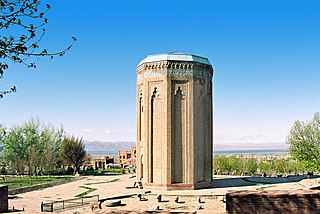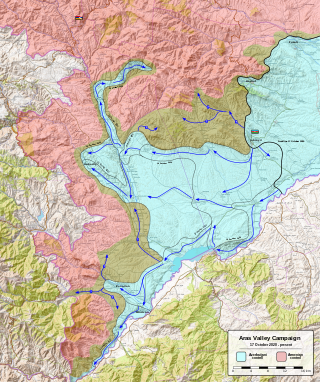Related Research Articles
Azerbaijan is administratively divided into 67 districts and 11 cities that are subordinate to the Republic. Out of these districts and cities, 7 districts and 1 city are located within the Nakhchivan Autonomous Republic. The districts are further divided into municipalities.

Shaki is a city in northwestern Azerbaijan, surrounded by the district of the same name. It is located in the southern part of the Greater Caucasus mountain range, 240 km (150 mi) from Baku. As of 2020, it has a population of 68,400. The center of the city and the Palace of Shaki Khans were inscribed in the UNESCO World Heritage List in 2019 because of their unique architecture and history as an important trading center along the Silk Road.
Tartar is a city in and the capital of the Tartar District of Azerbaijan.

Mammadbeyli is a village in the Zangilan District of Azerbaijan. The village is situated on the bank of Hakari river.

The Kurds in Azerbaijan form a part of the historically significant Kurdish population in the post-Soviet space. Kurds established a presence in the Caucasus with the establishment of the Kurdish Shaddadid dynasty in the 10th and 11th centuries. Some Kurdish tribes were recorded in Karabakh by the end of the sixteenth century. However, virtually the entire contemporary Kurdish population in the modern Azerbaijan descends from migrants from 19th-century Qajar Iran.
Azerbaijani art is the art created by Azerbaijanis. They have created rich and distinctive art, a major part of which is applied art items. This form of art rooted in antiquity, is represented by a wide range of handicrafts, such as chasing (metalworking), jewellery-making, engraving, carving wood, stone and bone, carpet-making, lacing, pattern weaving and printing, and knitting and embroidery. Each of these decorative arts is evidence of the culture and the abilities of the Azerbaijan nation, and are very popular there. Many interesting facts pertaining to the development of arts and crafts in Azerbaijan were reported by merchants, travellers and diplomats who visited these places at different times.

The Khinalugs are an indigenous people of Azerbaijan that speak the Khinalug language, a Northeast Caucasian language. The Khinalugs are indigenous to the Quba District and have been named after their main village, Khinalug. They are one of the peoples that have traditionally been called Shahdagh.

Nizami Street is a large pedestrian and shopping street in downtown Baku, Azerbaijan, named after classical Azerbaijan poet Nizami Ganjavi.

Arts of Caucasian Albania – is the historical and regional type of arts related to Ancient East.

The architectural school of Nakhchivan is one of the architectural schools developed in the Middle Ages in what is modern Azerbaijan. It was founded by Ajami Nakhchivani in the 12th century. The mausoleums of Yusif ibn Kuseyir from 1162 and Momine Khatun from 1186, designed by him in Nakhchivan, are classic examples of the associated architectural style.

Falsification of history in Azerbaijan is an evaluative definition, which, according to a number of authors, should characterize the historical research carried out in Azerbaijan with state support. The purpose of these studies, according to critics, is to exalt the Caucasian Albanians as the alleged ancestors of Azerbaijanis and to provide a historical basis for territorial disputes with Armenia. At the same time, the task is, firstly, to root Azerbaijanis in the territory of Azerbaijan, and secondly, to cleanse the latter of the Armenian heritage. In the sharpest and most detailed form, these accusations are presented by specialists from Armenia, but the same is said, for example, by Russian historians Victor Schnirelmann, Anatoly Yakobson, Vladimir Zakharov, Mikhail Meltyukhov and others, Iranian historian Hasan Javadi, American historians Philip L. Kohl and George Bournoutian.
This is an account of engagements which occurred during the Second Nagorno-Karabakh War, primarily based on announcements from the belligerents. The war has been characterized by the use of armoured warfare; drone warfare, especially the use of Turkish-made Bayraktar TB2 and Israeli loitering munition Harop drones; heavy artillery; rocket attacks; and trench warfare. It has also featured the deployment of cluster munitions, which are banned by the majority of the international community but not by Armenia or Azerbaijan: Azerbaijan states that Armenia has deployed cluster munitions against civilians, and international third parties have confirmed evidence of Azerbaijan's use of cluster munitions against civilian areas of Nagorno-Karabakh. A series of ballistic missile attacks have inflicted mass civilian casualties in Ganja, Azerbaijan, while civilian residences and infrastructure in Stepanakert, and elsewhere have been targeted, inflicting casualties and causing extensive damage.

The Aras Valley campaign was a military operation launched by Azerbaijan against the breakaway Republic of Artsakh along the Aras River in the Azerbaijan–Iran border during the Second Nagorno-Karabakh War.

Sakasena is a historical region on the territory of modern Azerbaijan. The former core of the 7th - 6th century BCE of the Scythian kingdom of Ishkuz. It got its name from the tribes of the Scythians, who later entered the tribal union of the Caucasian Albanians. At the end of the 6th - beginning of the 5th century BCE it was part of the satrapy Media under the Achaemenid Empire. At the beginning of the 2nd century BCE it was annexed to Greater Armenia, becoming the Gavar (district) of the Nahanga (province) of Utic. In the division of Great Armenia in 387, it went to the Caucasian Albania, which was, under the treaty, subordinate to the Sassanids. It was located South of the middle course of the Kura, in the area of modern Ganja.
With the outbreak of hostilities in the Caucasus as part of World war I, Azerbaijan was also involved in the war, being part of the Russian Empire. Baku oil was of particular importance.
The Khynysli treasure is a hoard of silver coins discovered near the village of Dere Khynysli in Shamakhi district of Azerbaijan.

Abdul Vahab Rahim oglu Salamzadeh, was a Soviet-Azerbaijani art critic, architect, doctor of art history, and academician. He had served as the deputy director of the Institute of Architecture and Art of the Academy of Sciences of the Azerbaijani SSR, and head of the department of history and theory of architecture in the same institute, and received the title of Honoured Builder of the Azerbaijan SSR.
Place names in Azerbaijan is a set of geographical names, including the names of natural and cultural objects on the territory of the Republic of Azerbaijan.

"Taghiyev’s Theater" is the first theater in Baku. It was built in 1883 at the expense of the industrialist and philanthropist Haji Zeynalabdin Taghiyev. It staged both national plays and operas, as well as the works of the world classics. Here, in January 1908, the premiere of the first Azerbaijani national opera "Leyli and Majnun", by Uzeyir Hajibeyov, took place.
References
- 1 2 3 4 5 6 "Азербайджанский город Барда и его древняя история (ФОТО)". История Азербайджана (in Russian). 7 February 2018. Retrieved 2021-01-07.
- ↑ "History of Barda". Archived from the original on 2007-01-27.
- ↑ "First historical studies of Barda" (PDF).
- ↑ Тревер К.В. (1959). Очерки по истории и культуре Кавказской Албании. М.-Л.: Издательство Академии Наук СССР.
- ↑ "История Барды". www.anl.az. Retrieved 2021-01-07.
- ↑ "Барда - столица амазонок". KASPIY.AZ. Retrieved 2021-01-07.
- ↑ Артамонов М.И. (1962). История хазар. Л: Изд-во Государственного Эрмитажа.
- ↑ Бартольд, В. В. Сочинения (in Russian). Рипол Классик. ISBN 978-5-88533-124-1.
- ↑ Буниядов З. (1965). Азербайджан в VII-IX вв. Издательство АН Азербайджанской ССР.
- ↑ "IRS" (PDF).
- 1 2 "Золотой век" городов Азербайджана". cyberleninka.ru. Retrieved 2021-01-07.
- ↑ "СБОРНИК МАТЕРИАЛОВ". www.vostlit.info. Retrieved 2021-01-07.
- ↑ Ашурбейли С. (2006). Государство Ширваншахов. Баку.
{{cite book}}: CS1 maint: location missing publisher (link) - ↑ Мамедов И. (2009). История Азербайджана (с древнейших времен до наших дней. «Маариф».
- ↑ История Азербайджана. Краткий очерк (С древнейших времен до XIX века). Баку. 1941. pp. 76–77.
{{cite book}}: CS1 maint: location missing publisher (link) - ↑ В. Н. Левиатов (1948). Очерки из истории Азербайджана в XVIII веке. Баку: Издательство АН Азербайджанской ССР. pp. 82–83.
- ↑ "Карабахская хроника: реконструкция этнической истории Карабаха по архивным материалам (1920-1924 гг.)". 1905.az (in Russian). Retrieved 2021-01-07.
- ↑ "Azerbaijani SSR" (PDF). Archived from the original (PDF) on 2021-11-10.
- ↑ Azerbaijan: Azerbaijani mugam. Human Rights Watch. 2015.
- ↑ "Официальный сайт президента Азербайджанской Республики - НОВОСТИ » Мероприятия". ru.president.az (in Russian). Retrieved 2021-01-07.
- ↑ "Территория Барды подвергся обстрелу из тактического ракетного комплекса "Точка-У"". МИНИСТЕРСТВО ОБОРОНЫ АЗЕРБАЙДЖАНСКОЙ РЕСПУБЛИКИ (in Russian). Retrieved 2021-01-07.
- ↑ "Обстрелы городов и тактическое отступление. Девятый день войны в Карабахе. Главное". BBC News Русская служба (in Russian). 2020-10-05. Retrieved 2021-01-07.
- ↑ Агеев, Алексей (2020-10-28). "Число погибших при обстреле азербайджанского города Барда выросло до 14". Известия (in Russian). Retrieved 2021-01-07.
- ↑ Узел, Кавказский. "Выросло число погибших в результате обстрела Барды". Кавказский Узел. Retrieved 2021-01-07.
- 1 2 Fly. "Барда". Путешествия Без Наценок (in Russian). Archived from the original on 2021-01-09. Retrieved 2021-01-07.
- ↑ Усейнов М. А. (1963). История архитектуры Азербайджана. М: Государственное издательство литературы по строительству, архитектуре и строительным материалам. p. 39.
- ↑ "Древний мост в Барде остается одним из последних свидетелей истории города". bakuinform.az (in Russian). Retrieved 2021-01-07.